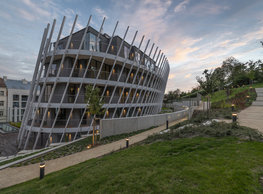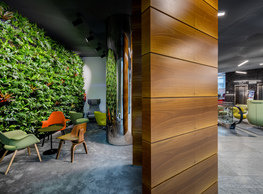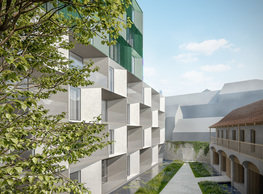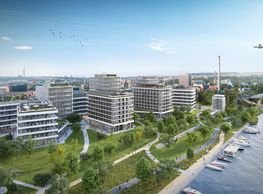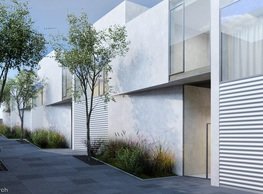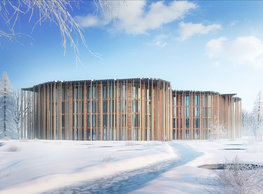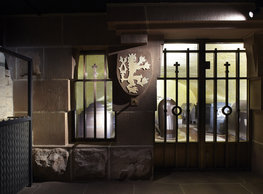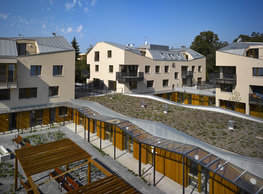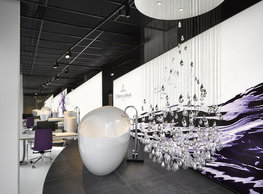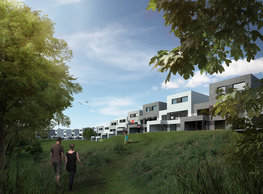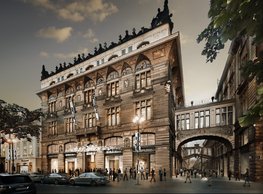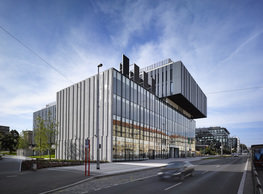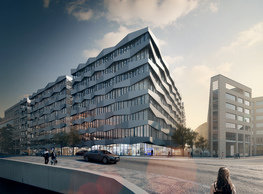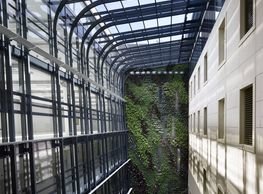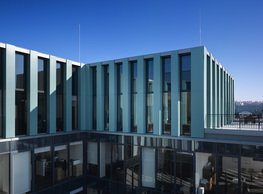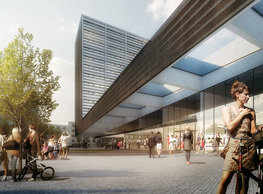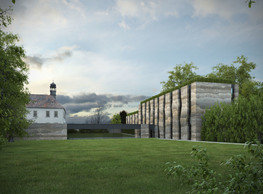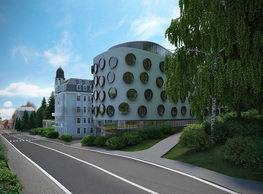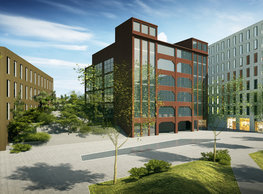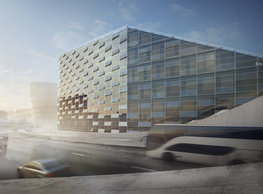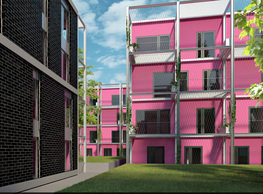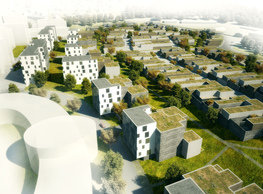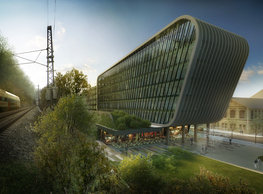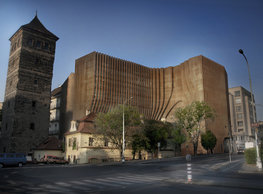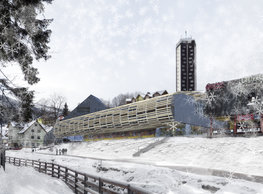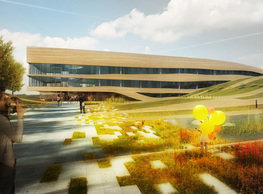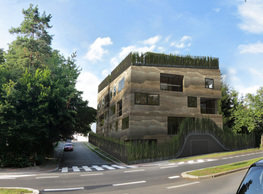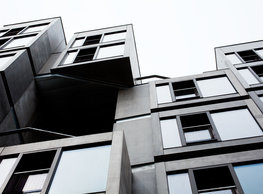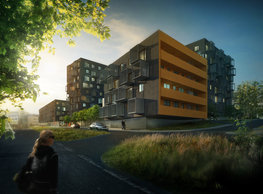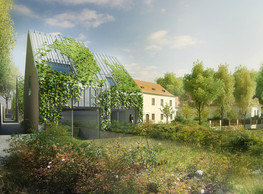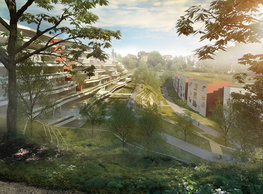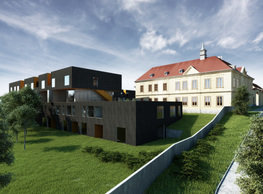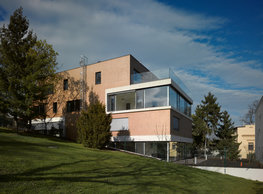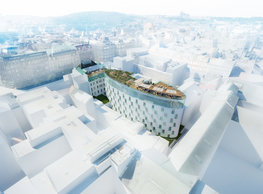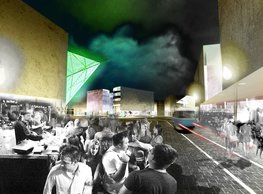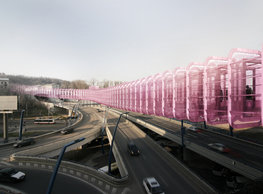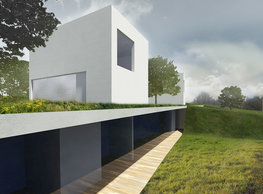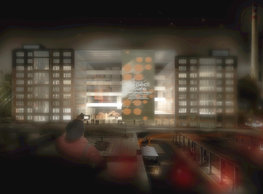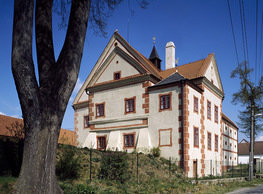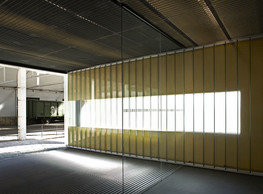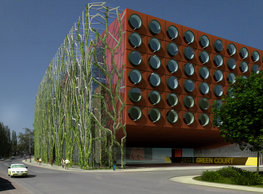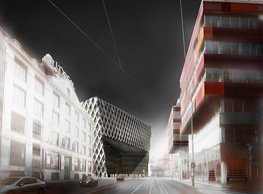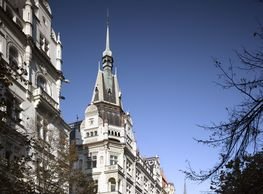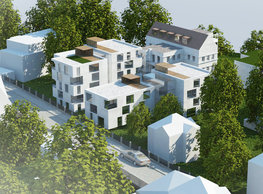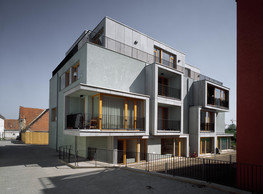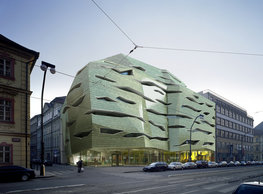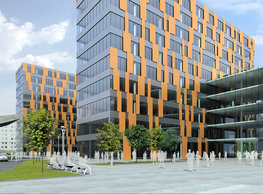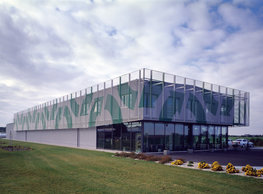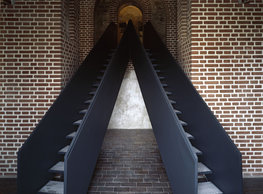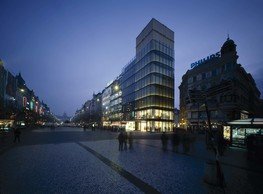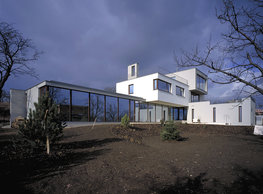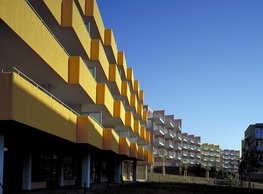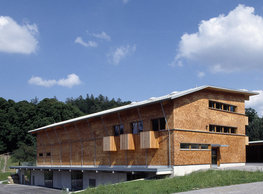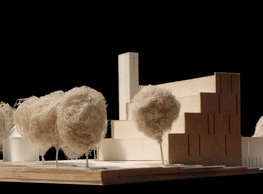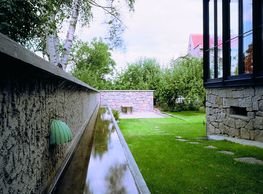We consider the distinctly horizontal and relatively low mass of the existing shopping centre as positive. That is why we are ever since the beginning of our work on the project that this quality should be preserved in the new volumetric design. We propose adding two more stories above the shopping centre on the south side and three on the north side. We deal with the layout – which is too deep for living – by making it even deeper. Though ironically, this arrangement will allow grouping the addition in two parallel rows of flats oriented to the south clustered around a grand-scale internal atrium – a common terrace. The addition is optically clad by a unifying envelope of timber boards. We can say that since the character of the mass will remain unchanged after the conversion and because we do not intend to increase the number of stories in the new building, the effect of the original volume will not change from the perspective of a passer-by. The open atrium is the centre of the layout of the top residential floors. The addition is allocated for smaller units that can be efficiently serviced by a horizontal corridor. Despite its length, this corridor can be a pleasing environment because it is perfectly daylighted. Logically, for we do not increase the current volume too much, the remaining necessary capacity must be located somewhere. That is why a separate extension is added. It is proposed on the west side of the site instead of the current dead-end service road. Contrary to the added volume, we design a high, slender volume here contrasting with the long ´log´. It is shaped as a simple quadratic form transformed by breaking and cutting to establish a logical entry into the compound and so that the new building would block as little sunlight to the addition built on the original centre as possible. A formation with a ´ridged roof´ is established this way – traditionally, the ridge is parallel to the contour line: a building – monolith that does not distinguish between a wall and a roof – simply a ´rock´. The addition is intentionally higher than the ´log´; the buildings are in a sort of juxtaposition. The original morphology of the slope is ´restored´ by covering the actual cut (supply yard) by a green roof from the north. For the addition, we work with a transposed metaphor of a compact mass – a log that sort of ´landed´ on the pedestal formed by the original renovated ground-floor building. That is also why we selected wood as an adequate natural element for the outer cladding material. Using timber logs (ca 10 cm in diameter) allows working with variable density of this covering grating (it almost disappears above the common terrace, for example); yet the unifying function of this layer is vital as soon as you realise that the roof is the fifth facade in our case. This way conceived element establishes a soffit, a balustrade, or a pergola or a shading jalousie here and there, depending on the position along the envelope. This approach strictly distinguishes between the principle of a rougher light surface skin and the contrast internal mass (apartments) which is smooth and dark on the surface of the cut. The crucial element of materialising is some complementarity of the concept of the new building and the extension. While the extension has wood on the surface and the dark surface inside, the new building has it the other way around. It is covered by a unified dark material forming the surface of the wall and the roof (e.g. Eternit (fibre-cement) shingles, fine sheet metal, and similar), white the cuts in this mass in the form of recessed loggias are clad in wood.
portfolio
![]()
monastery of st. gabriel
![]()
nová zbrojovka block g
![]()
nad krocínkou a
![]()
nad krocínkou b
![]()
nymburk train station
![]()
stará boleslav primary school
![]()
holečkova 26 residence
![]()
komořany elementary school
![]()
kindergarten jeseniova
![]()
dobřichovice farmstead
![]()
nová elektra residence
![]()
filadelfie bldg. – the new reception
![]()
písnice elementary school
![]()
bytové domy vítězná/újezd
![]()
afi vokovice
![]()
showroom elite bath/bulthaup sk
![]()
port 7
![]()
main point pankrác
![]()
oktáva houses
![]()
lesy čr headquarters
![]()
royal tomb
![]()
dob centre in dobřichovice
![]()
elite bath showroom karlín
![]()
pod hády brno
![]()
communal flats in dolní břežany
![]()
contemporary glass muzeum
![]()
the blox
![]()
šantovka residence
![]()
open gate II
![]()
ružinov office building
![]()
vinohradská 8
![]()
jindřišská 16
![]()
masarykovo railway station
![]()
retail and office development
![]()
regina hradec králové
![]()
jungmannova 15
![]()
chateau dolní břežany
![]()
dlouhá palace
![]()
the metropole hotel in mariánské lázně (marienbad)
![]()
square mechanica
![]()
plzeňská 18
![]()
porto mercandini
![]()
vrchlického residence
![]()
waltrovka
![]()
karlín railway
![]()
novomlýnská brána
![]()
main point karlin
![]()
sněžka apartment house
![]()
science research centre
![]()
jeremenkova residence
![]()
flat b3 prague
![]()
tenement house with a gym
![]()
štěpánská 47
![]()
footbridge in bb centre
![]()
botanica vidoule phase 6
![]()
hendlův dvůr
![]()
klamovka residential complex
![]()
perníkářka manor
![]()
švédská residence
![]()
evropa hotel
![]()
bb centrum filadelfie
![]()
černá louka ostrava
![]()
municipal interventions prague 2010
![]()
family houses in radotín
![]()
cherubín II
![]()
zlín cultural centre
![]()
ostrolovský újezd chateau
![]()
fc bohemians praha 1905
![]()
znojemská hospice
![]()
pilsner urquell
![]()
st. wenceslas exposition
![]()
karlov office building
![]()
petynka hotel
![]()
institute of noblewomen
![]()
cherub I
![]()
pařížská 9
![]()
sanopz residential complex
![]()
jinonice villa park
![]()
viktoria center pankrác
![]()
hotel crystal palace
![]()
invalidovna offices
![]()
performing arts center seoul
![]()
toner recycling company building
![]()
boscolo carlo IV hotel
![]()
the story of prague castle
![]()
umprum in prague-ďáblice
![]()
mrázovka apartment villa
![]()
school gym in prague-troja
![]()
roma hotel
![]()
euro palace
![]()
ten centuries of architecture
![]()
villa třešňovka
![]()
velká skála
![]()
sternberg palace prague castle
![]()
st. nicholas church in čečovice
![]()
olga and václav havel's villa
![]()
tierpark langenberg
![]()
a church in neratovice
![]()
school centre interlaken
![]()
forestry school in lyss
![]()
villa dobeška
![]()
tuscany in maps






